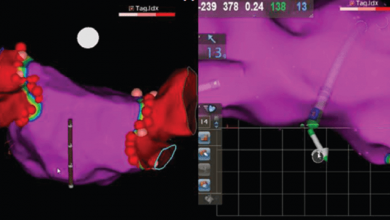Search results
Zero X-ray Ablation
Author(s):
Giuseppe Mascia
,
Marzia Giaccardi
Added:
3 years ago
Article
Author(s):
Xianxian Jiang
Added:
3 years ago
Author(s):
Kenichiro Yamagata
,
Bashar Aldhoon
,
Josef Kautzner
Added:
3 years ago
The number of catheter ablations for atrial fibrillation (AF) treatment has gradually increased over the last 15 years since the first report on the importance of pulmonary vein (PV) foci for triggering AF.1 Catheter ablation for AF is a complex procedure with multiple steps, such as transseptal puncture, mapping of the left atrium and PVs and extensive linear ablation around PV ostia. Not…
View more
Author(s):
Georg Nölker
,
Dieter Horstkotte
,
Klaus-Jürgen Gutleben
Added:
3 years ago
Catheter ablation is an established treatment option for patients with symptomatic atrial fibrillation (AF).1-3 Pulmonary vein (PV) angiography has been the initial imaging tool in AF ablation and is still used by up to 50 % of leading electrophysiologists.3 PV angiography still plays a major role in balloon-based ablation techniques routinely performed without electroanatomical mapping (EAM)…
View more
Convergent AF Ablation
Author(s):
Karan Wats
,
Andy Kiser
,
Kevin Makati
,
et al
Added:
3 years ago
Article
Author(s):
Vincent Umbrain
,
Christian Verborgh
,
Gian-Battista Chierchia
,
et al
Added:
3 years ago
The current option for refractory treatment for atrial fibrillation (AF) includes hybrid AF-surgery.1–2 The hybrid approach was originally a combination of mini-invasive surgical epicardial evaluation and ablation, as well as endocardial electrophysiologist (EP) catheter ablation with the intention of creating a lesion set to cure AF.3 In the search for greater efficacy with less patient…
View more
Author(s):
David Filgueiras-Rama
,
Jose L Merino
Added:
3 years ago
Atrial fibrillation (AF) is the most common sustained arrhythmia in the clinical practice.1 The prevalence of the arrhythmia is progressively increasing in developed countries and moreover, it is expected to affect up to 12 million people only in the US by 2050.2 Antiarrhythmic drugs continue to represent the first-line of treatment in AF patients, either to restore sinus rhythm or to prevent…
View more
Author(s):
Lluis Mont
,
Ivo Roca-Luque
,
Till F Althoff
Added:
2 years ago
Author(s):
Laurent Roten
,
Matthew Daly
,
Patrizio Pascale
,
et al
Added:
3 years ago
With an ageing population and widespread use of implantable cardioverter-defibrillators, physicians are confronted with an increasing number of patients with symptomatic, drug-refractory ventricular tachycardia (VT). Catheter ablation is an important treatment option in the management of patients with structural heart disease and VT.1,2 In many patients, VT can be successfully ablated from the…
View more
Author(s):
Jean-Baptiste Gourraud
,
Jason G Andrade
,
Laurent Macle
,
et al
Added:
3 years ago
Atrial fibrillation (AF) is the most common sustained cardiac arrhythmia observed in clinical practice, occurring in approximately 2 % of the general population.1–3 A progressive increase in both the prevalence and incidence of AF has been demonstrated in recent years, defining AF as a major economic and public health issue.1
The identification of sites of AF initiation and/or maintenance within…
View more













